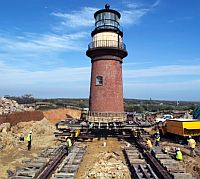 Recently, Gay Head lighthouse on Martha’s Vineyard, off the coast of Massachusetts, was very carefully jacked up and moved 135 feet inland, far enough away from the crumbling red clay cliffs of Gay Head to prevent it toppling into the ocean. The lighthouse should be reopened to the public by sometime in July. There has been a lighthouse on Gay Head since 1799. The current lighthouse dates from 1856. There is a video of the move after the page break.
Recently, Gay Head lighthouse on Martha’s Vineyard, off the coast of Massachusetts, was very carefully jacked up and moved 135 feet inland, far enough away from the crumbling red clay cliffs of Gay Head to prevent it toppling into the ocean. The lighthouse should be reopened to the public by sometime in July. There has been a lighthouse on Gay Head since 1799. The current lighthouse dates from 1856. There is a video of the move after the page break.
The problem of cliffs eroding beneath lighthouses is not unique to Martha’s Vineyard. Just 35 nautical miles to the west, across Rhode Island Sound, Block Island has had more than its share of problems with lighthouses. The island was named for the Dutch explorer, Adrian Block, but was known to mariners as the “stumbling block” because so many ships went aground on its shores. The Southeast lighthouse was built in 1874 on the 160′ high Monhegan bluffs on the southern end of the island. When built, it was roughly 300 feet from the cliff’s edge. By 1990, the lighthouse was within 50 feet of the edge of the bluff. A group of local volunteers formed the Block Island Southeast Lighthouse Foundation and raised the necessary funds to move the lighthouse 230 feet farther inland in 1993. The firm that moved the Block Island light would later also move lighthouses on Highland Lighthouse and Nauset Lighthouse on Cape Cod, Nantucket’s Sankaty Head Lighthouse, and Cape Hatteras in North Carolina.
On the north end of Block Island, the North light has been built, washed away and rebuilt four times between the first lighthouse of 1829 and 1867 when the current granite and iron lighthouse was built now on Sandy Point to mark the treacherous shoals to the north of the island.
Thanks to Phil Leon for contributing to this post.
